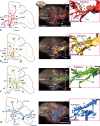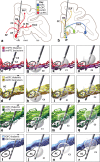Rules ventral prefrontal cortical axons use to reach their targets: implications for diffusion tensor imaging tractography and deep brain stimulation for psychiatric illness
- PMID: 21753016
- PMCID: PMC3445013
- DOI: 10.1523/JNEUROSCI.0595-11.2011
Rules ventral prefrontal cortical axons use to reach their targets: implications for diffusion tensor imaging tractography and deep brain stimulation for psychiatric illness
Abstract
The ventral prefrontal cortex (vPFC) is involved in reinforcement-based learning and is associated with depression, obsessive-compulsive disorder, and addiction. Neuroimaging is increasingly used to develop models of vPFC connections, to examine white matter (WM) integrity, and to target surgical interventions, including deep brain stimulation. We used primate (Macaca nemestrina/Macaca fascicularis) tracing studies and 3D reconstructions of WM tracts to delineate the rules vPFC projections follow to reach their targets. vPFC efferent axons travel through the uncinate fasciculus, connecting different vPFC regions and linking different functional regions. The uncinate fasciculus also is a conduit for vPFC fibers to reach other cortical bundles. Fibers in the internal capsule are organized according to destination. Thalamic fibers from each vPFC region travel dorsal to their brainstem fibers. The results show regional differences in the trajectories of fibers from different vPFC areas. Overall, the medial/lateral vPFC position dictates the route that fibers take to enter major WM tracts, as well as the position within specific tracts: axons from medial vPFC regions travel ventral to those from more lateral areas. This arrangement, coupled with dorsal/ventral organization of thalamic/brainstem fibers through the internal capsule, results in a complex mingling of thalamic and brainstem axons from different vPFC areas. Together, these data provide the foundation for dividing vPFC WM bundles into functional components and for predicting what is likely to be carried at different points through each bundle. These results also help determine the specific connections that are likely to be captured at different neurosurgical targets.
Figures










References
-
- Amaral DG, Price JL, Pitkanen A, Carmichael ST. Anatomical organization of the primate amygdaloid complex. In: Aggleton JP, editor. The amygdala: neurobiological aspects of emotion, memory, and mental dysfunction. New York: Wiley; 1992. pp. 1–66.
-
- Beevor CE, Horsley V. An experimental investigation into the arrangement of the excitable fibres of the internal capsule of the bonnet monkey (Macacus sinicus) Philos Trans R Soc Lond B Biol Sci. 1890;181:49–88.
-
- Browning PG, Gaffan D. Impairment in object-in-place scene learning after uncinate fascicle section in macaque monkeys. Behav Neurosci. 2008;122:477–482. - PubMed
Publication types
MeSH terms
Grants and funding
LinkOut - more resources
Full Text Sources
